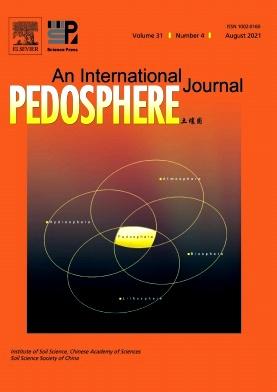Cadmium detoxification by Stenotrophomonas sp. via cell wall exfoliation and regeneration mediated by mtgA
IF 7.3
2区 农林科学
Q1 SOIL SCIENCE
引用次数: 0
Abstract
Understanding bacterial strategies for coping with heavy metal stress is essential for elucidating their resilience in contaminated environments. However, whether cell wall exfoliation contributes to bacterial tolerance under heavy metal stress, such as cadmium (Cd) exposure, remains unclear and requires further investigation. In this study, we reveal a novel self-protective mechanism in Stenotrophomonas sp. H225 isolated from a Cd-contaminated farmland soil, which underwent controlled cell wall exfoliation and regeneration in response to Cd stress up to 200 mg L-1. Transmission electron microscopy and energy-dispersive X-ray spectroscopy analyses revealed that the exfoliated cell wall fragments served as extracellular Cd sinks, thereby reducing intracellular Cd accumulation. Fourier-transform infrared spectroscopy and enzyme-linked immunosorbent assay indicated progressive peptidoglycan (PG) degradation, with exfoliated PG concentration in solution increasing from 148 ng mL-1 at 0 mg L-1 Cd to 240 ng mL-1 at 200 mg L-1 Cd. This degradation was counteracted by the compensatory upregulation of PG biosynthesis genes, with the enrichment ratio reaching up to 0.83, facilitating cell wall reconstruction. Transcriptomic analysis and gene knockout experiments identified mtgA (encoding a monofunctional transglycosylase) as a key determinant in cell wall repair and Cd resistance. To our knowledge, this is the first mechanistic evidence that bacteria can mitigate heavy metal toxicity through dynamic cell wall remodeling involving exfoliation and regeneration. This finding enhances our understanding of microbial survival strategies under environmental stress and highlights potential targets for engineering metal-tolerant strains for bioremediation applications.
mtgA介导的窄养单胞菌细胞壁脱落和再生对镉的解毒作用
了解细菌应对重金属胁迫的策略对于阐明它们在污染环境中的恢复能力至关重要。然而,细胞壁脱落是否有助于细菌在重金属胁迫下的耐受性,如镉(Cd)暴露,尚不清楚,需要进一步研究。在这项研究中,我们揭示了从Cd污染的农田土壤中分离的窄养单胞菌sp. H225的一种新的自我保护机制,该细胞在高达200 mg L-1的Cd胁迫下进行了控制的细胞壁脱落和再生。透射电镜和能量色散x射线能谱分析表明,脱落的细胞壁碎片起到了细胞外Cd汇的作用,从而减少了细胞内Cd的积累。傅里叶变换红外光谱和酶联免疫吸附实验表明,多糖(PG)的降解是渐进式的,脱落的PG在溶液中的浓度从0 mg L-1 Cd时的148 ng mL-1增加到200 mg L-1 Cd时的240 ng mL-1。这种降解被PG生物合成基因的代偿性上调所抵消,富集比达到0.83,有利于细胞壁的重建。转录组学分析和基因敲除实验发现,mtgA(编码单功能转糖基化酶)是细胞壁修复和抗Cd的关键决定因素。据我们所知,这是第一个机制证据,表明细菌可以通过包括脱落和再生在内的动态细胞壁重塑来减轻重金属毒性。这一发现增强了我们对环境胁迫下微生物生存策略的理解,并突出了工程耐金属菌株用于生物修复应用的潜在目标。
本文章由计算机程序翻译,如有差异,请以英文原文为准。
求助全文
约1分钟内获得全文
求助全文
来源期刊

Pedosphere
环境科学-土壤科学
CiteScore
11.70
自引率
1.80%
发文量
147
审稿时长
5.0 months
期刊介绍:
PEDOSPHERE—a peer-reviewed international journal published bimonthly in English—welcomes submissions from scientists around the world under a broad scope of topics relevant to timely, high quality original research findings, especially up-to-date achievements and advances in the entire field of soil science studies dealing with environmental science, ecology, agriculture, bioscience, geoscience, forestry, etc. It publishes mainly original research articles as well as some reviews, mini reviews, short communications and special issues.
 求助内容:
求助内容: 应助结果提醒方式:
应助结果提醒方式:


